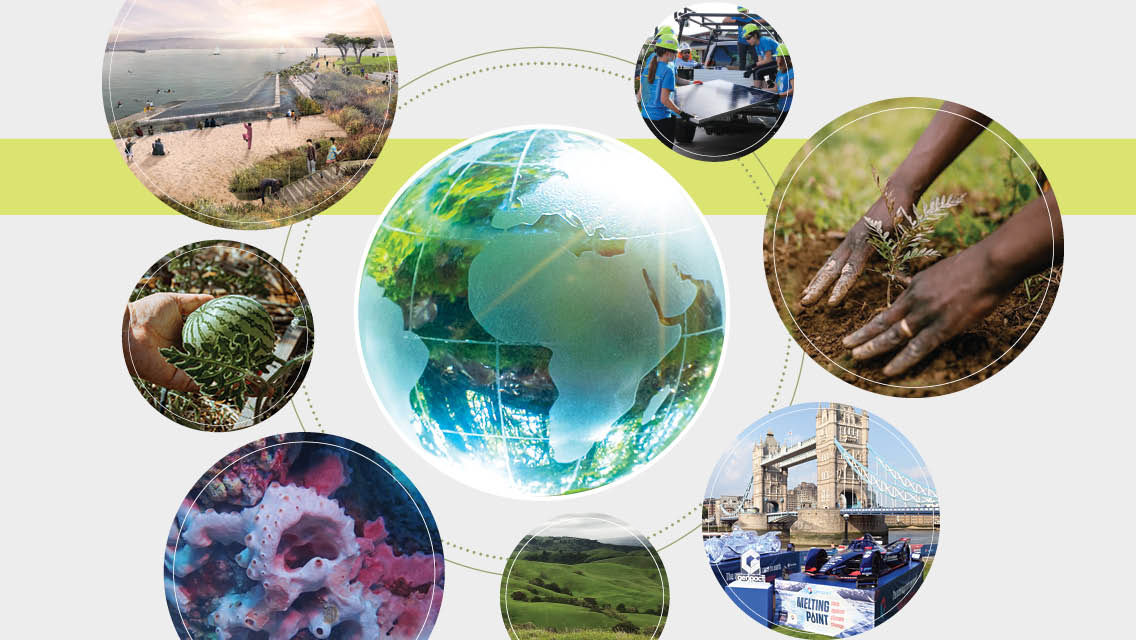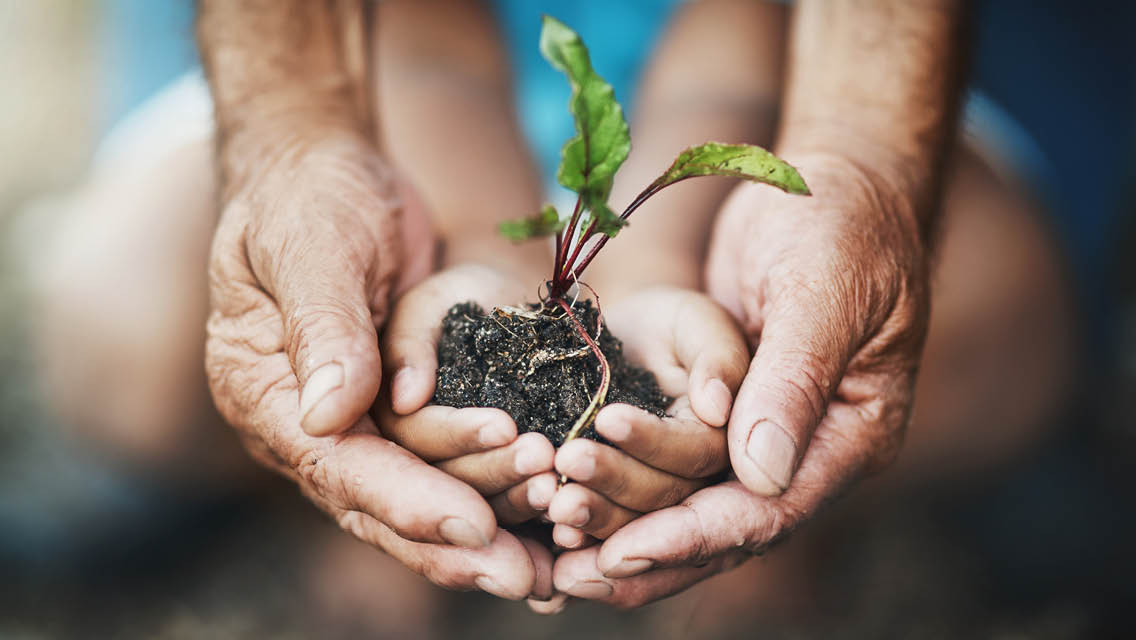When it comes to the health of the planet, there is plenty of reason for concern. In 2021, the United Nations (UN) issued a report that the secretary general described as a “code red for humanity.” Temperatures are rising faster than anticipated, and we’re “perilously close” to crossing the threshold of 1.5 degrees C above preindustrial levels of global heating.
The catastrophic effects of these increasing temperatures include rising seas, stronger storms, and accelerating species extinction.
So it isn’t surprising that, for many of us, climate change feels like the battle of our lifetimes. And without a doubt, taking a fierce attitude toward flagrant polluters is often exactly what’s needed to protect watersheds from toxins, or species from the threat of extinction.
Yet thinking about climate advocacy solely as a fight can also backfire. Longtime activist and advocate Paul Hawken has suggested that if we want to make a positive contribution, we may need to shift to an affirmative mindset rather than an embattled one wherever possible.
“You cannot fight change,” Hawken notes. “The language and mindset of healing the earth and atmosphere needs to employ these words: restore, renew, rejuvenate, regeneration, connect, purpose, meaning, and respect.”
Other activists agree. “Of course, what’s happening is frightening, and it’s natural to feel as if you need to take charge and push back as a way to be in control,” says Melody Brenna, CEO and cofounder of Reef Life Foundation.
“But how about taking a step back instead?” she suggests. “Let’s look at climate-adaptation strategies that work with the environment, that restore and replenish in a way that respects the natural world.”
In this spirit, we’re sharing the stories of some organizations that are taking an affirmative, regenerative approach. Whether rethinking ice melt or restocking oyster beds, these groups are working with the climate as it changes rather than against it. In the process, they’re offering myriad ways we can partner with the natural world as we move forward — with a little more hope — into whatever future awaits us.
Arctic Ice Project
Rising temperatures are wreaking havoc everywhere, but especially in the Arctic. In 2018, the National Oceanic and Atmospheric Administration (NOAA) estimated that since 1985, about 95 percent of the Arctic Ocean’s oldest sea ice had melted.
This ice loss has led to the near extinction of polar bears and triggered more extreme winter weather everywhere. It’s also contributing to rising sea levels and increased drought.
According to the nonprofit Arctic Council, temperatures in the region — which covers some 5.5 million square miles — are rising at three times the global annual average.
One organization is proposing a stopgap measure to buy time for researchers seeking to slow rising temps: Until we can cool it all down, make the Arctic ice older. Not colder, but older.
Here’s why: With ice, age brings power. When ice is at least four years old (and especially when it is decades or centuries old), its formidable thickness makes it more durable against the melting effects of sunlight.
By comparison, the paper-thin ice that forms when parts of the Arctic Ocean freeze in autumn is more vulnerable to sun melt, as well as fracture from wind and destruction from waves. When this young ice stops turning into old ice, we’ll be in even bigger trouble than we are now. That’s where the Arctic Ice Project comes in.
“The Arctic is our planet’s heat shield,” says executive director Tom Light. “When the ice melts, you lose that protection, and the open sea water absorbs the sun’s heat. Our technology can stop the ice from melting.”
Their nontoxic covering is made from silica (a compound derived from silicon and oxygen) and looks like fake snow. When used to coat young ice, it protects it from melting so it can age.
“The ice loss in the Arctic is contributing to 25 to 50 percent of global temperature rise,” Light says. “By stopping the melt, we can provide time for the world’s economies to decarbonize and stave off the worst climate risks.”
One Tree Planted
Planting trees is a more complicated and controversial sustainability effort than it might seem. The logging industry sometimes promotes it to justify clear-cuts instead of more sustainable harvesting methods. Yet those newly planted trees take decades to mature, and they rarely re-create the biodiversity that’s lost by clear-cutting.
That’s why One Tree Planted, a nonprofit based in Vermont, focuses on a big-picture reforestation strategy, says founder Matt Hill.
Through more than 300 partnerships with local networks in 44 countries, One Tree Planted supports projects that offer benefits for the landscape and communities. It planted over 1.2 million trees in California in 2021 for forest-fire recovery, with a broader goal of reducing soil erosion, lowering flood risk, and restoring biodiversity.
Another effort in Rwanda is creating agroforestry jobs for women’s empowerment. Meanwhile, a planting initiative in Canada aims to restore dwindling caribou numbers: Tree density reduces sightlines for their predators and expanded habitat supports mating.
An effort in Iceland is helping to sequester carbon by introducing trees to areas that were grazed down centuries ago, and another in Indonesia is creating more habitat for orangutans and other endangered wildlife by restoring rainforest.
“Trees help clean the air by releasing oxygen, but they also contribute to healthy ecosystems,” Hill says. “A project to plant 1.5 million trees in riparian zones in the Pacific Northwest will help clean polluted waters and support the salmon population. That, in turn, helps the Southern Resident orca whales through cleaner water and a better food supply.”
Another initiative, in Arkansas, is designed to create cleaner drinking water in low-income areas. “Trees are filters that improve soil quality and water quality, but it just goes well beyond that,” he explains. “We’re not just replacing trees that were cut down through logging or lost to wildfires. We’re looking at what trees can do for an area in terms of biodiversity, economic growth, and climate adaptation.”
“Carbon offsets have their place, but our philosophy is that you can’t buy away your environmental sins,” he adds. “You need to focus on not creating pollution in the first place, and supporting restoration to bring back natural ecosystem services. We believe trees have a major role in that.”
Reef Life Foundation
Warmer oceans are killing coral reefs. The UN has reported that 70 percent of the world’s reefs are under threat, with 24 percent at imminent risk of collapse and 20 percent now damaged beyond repair.
“There’s not enough biodiversity left,” says Melody Brenna of the Utah-based Reef Life Foundation. “We might have a decade, if we’re lucky, to save what’s remaining.”
Her organization is committed to the effort. That’s because coral reefs aren’t just pretty locales for divers; they play a significant role in protecting ocean health. A quarter of the world’s marine species are dependent on coral reefs at some point in their lifetimes, and coral reefs protect coastlines from erosion.
People have tried to rebuild reefs by stacking old tires, concrete blocks, and steel pipes alongside them, Brenna notes. It’s unclear whether these artificial reefs will support coral and multispecies growth over time, but they carry the risk of introducing more toxins into the water. Concrete, for instance, is alkaline, and can burn fish scales. Solving one problem creates another.
In 2006, researchers and activists seeking a better method approached Brenna, who had studied structures built with natural minerals that mimic the ocean floor. Coral is a tiny marine animal, and coral structures are made of thousands of tiny coral polyps that attach themselves to rocks or other hard, submerged surfaces.
Brenna’s mineral mixtures, called Oceanite, feature compositions similar to the surfaces to which coral usually attaches. Together the groups began developing a product called IntelliReefs. They were placed in three ocean beds off Sint Maarten in the Caribbean, where they were an instant hit.
“The next day, we had divers taking photos of goatfish napping in these reefs,” she recalls. “The divers had never seen this happen so fast. Then, coral started to grow, and you’ve got a family of octopi living in the middle. That’s when we thought, Maybe we’ve got a shot in this race against time.”
IntelliReefs are now being tested in other locations. A site in Canada is helping to rebuild kelp forests along the Eastern Shore. This not only protects coastline but restores sea life.
The UN and UNESCO recently endorsed IntelliReefs, which may help encourage government investment in reef rebuilding. These efforts would support tourism in coastal communities as well as support marine plant and animal species. “We simply can’t lose the ocean,” Brenna says. “We don’t have a minute to waste.”
Kiss the Ground
How food is grown, ranched, and fished can play a major role in climate shifts, contributing to drought, floods, and other disruptive forces that, in turn, often lead to greater dependence on unsustainable methods — like using more water and pesticides — to maintain food production.
A regenerative-agriculture model takes a different approach. It seeks to work with the land and even the weather, rather than escalating the war between farm and environment.
But implementing this type of farming takes education, funding, and other forms of support. That’s where Kiss the Ground (KTG) comes in. The California-based organization aims to make it easier for farmers to adopt sustainable practices.
Cofounder Ryland Engelhart describes the group’s work as a “mission to awaken” people about the possibilities of regenerative agriculture. And it’s working.
“Soil is suddenly ‘sexy,’” says Engelhart. “Some of the world’s biggest brands have come to adopt the regenerative view and language, which is to understand that we must do more than sustain a broken system.”
A group of concerned friends launched KTG in 2013 after researching regenerative land practices. They discovered an approach that “views land as a living system to participate in,” Engelhart says. He recently co-produced a Netflix documentary on regenerative farming — also called Kiss the Ground — to help boost public awareness of the need to climate-adapt our food systems.
Today KTG’s stewardship program offers training in soil health and regenerative methods for home gardens and neighborhoods. They also provide mentorship, as well as scholarships and financial assistance, to farmers and ranchers — especially those who are low-income, people of color, immigrants, or LGBTQIA+, and seeking to shift to a regenerative approach.
“Plenty of data show that a more biodiverse and biologically healthy system will outperform and outlast a conventionally and chemically dependent agricultural system during extreme weather events,” Engelhart says. “Just like a healthy immune system can ward off potential pathogens, healthy ecosystems can similarly ward off the pressures that come with a changing climate.”
SCAPE Studio
Landscape architecture combines built and natural environments to support human communities. But the practice can also design environments to support other creatures, such as oysters.
Based in New York City and New Orleans, SCAPE Studio created a method — dubbed “oyster-tecture” — that partners with oysters to protect New York City’s shoreline from storm surges and erosion. Originally commissioned by the Museum of Modern Art in 2009, the project uses a web of woven rope and plenty of eelgrass to create a living reef in the New York Harbor filled with oysters and mussels.
Not only does the reef create a breakwater for waves, but it also provides a natural filtration system that cleans millions of gallons of harbor water, thanks to the biotic cleansing abilities of the grass and mollusks. This restores biodiversity to the tidal marshes and improves water quality for residents — human and shelled alike.
Oyster-tecture is one feature of a larger SCAPE-led project called Living Breakwaters, which employs a variety of sustainable materials to build protective reefs. These are presently being tested near a handful of vulnerable coastlines, including the marshes around New Orleans.
Santa Cruz Mountains Stewardship Network
The Santa Cruz region is home to redwood forests, grasslands, and coastline, as well as some tourist-dependent towns, farms, and universities. Groups with a stake in the future of the land include Native tribes, logging companies, community residents, utilities, farmers, and conservation agencies.
Helping these diverse stakeholders collaborate to protect their shared land is the role of the Santa Cruz Mountains Stewardship Network (SCMSN).
“All of these different organizations want different things from the land,” says manager Dylan Skybrook. “They need a way to come together to ensure they can address those needs but also think at a landscape scale to care for the region as a whole.”
The SCMSN provides the research that fosters that perspective. For example, the organization recently commissioned a climate-change vulnerability assessment that reviewed nine important species and 10 habitats in the region. That report will help direct attention and money to the most effective climate-adaptation efforts.
Skybrook’s job involves explaining why certain aspects of the report — such as protecting the area’s endangered species — matter to everyone, not just conservation groups. The endangered species include coho salmon, the San Francisco garter snake, and the California red-legged frog.
“Because when you start taking nodes out of the food web, the whole thing stops functioning,” he notes. “This isn’t just about frogs, snakes, or salmon. Ensuring their survival keeps this ecosystem intact.”
Organizations like the SCMSN provide members with the big-picture view that’s easy to miss from an individual-stakeholder perspective. “Climate change affects all of us on a larger scale, not just a property-by-property scale,” says Skybrook. “That means we need collaboration, not conflict.”
GRID Alternatives
For humans to have a chance of successfully adapting to climate change, it will take everyone getting onboard. This is currently a major stumbling block, in part because economically disadvantaged communities may not have the resources to participate in sustainability efforts — even if they’re eager to do so.
One example is solar power. Installing solar panels on homes and businesses is a boon to energy savings, but the upfront cost of the panels is prohibitive, and utility rebates cover only so much.
For the past two decades, GRID Alternatives has been working to address this gap by creating access to renewable energy. “You shouldn’t have to go into debt to be green,” says Ashley Christy, executive director of GRID Alternative’s Greater Los Angeles office.
The California-based organization maintains eight offices and a tribal program in the United States, as well as an international program that serves Nicaragua, Nepal, and Mexico. Since its founding in 2001, GRID has installed over 17,000 solar systems and trained more than 45,000 installation professionals, with a particular emphasis on jobs for women and people of color.
The group also provides solar-energy education to K–12 students and offers programs to high school students to create career paths in the solar industry. GRID partners with community groups to develop shared solar arrays that benefit individual homeowners and affordable-housing programs, too.
“As climate change progresses, our reliance on clean energy is going to increase,” says Christy. “We need a workforce that is trained to get us where we need to be, and the technology needs to be available to everyone. Why should a 75-year-old grandmother on a fixed income be considered less worthy of a solar system just because she doesn’t have the $25,000 to invest in one?”
Christy’s ambitious goals include providing solar panels for every house and apartment building and growing the green-energy workforce by hundreds of thousands. She admits that leaving no one without access to clean energy is a lofty goal. But it’s the big dreams that sustain the momentum.
“Let’s get to the point where everyone is part of the green economy,” she says. “We all need to be part of the solution, now more than ever.”
This article originally appeared as “Climate Champions” in the April 2022 issue of Experience Life.





This Post Has 0 Comments